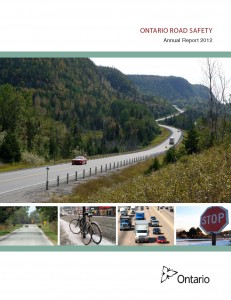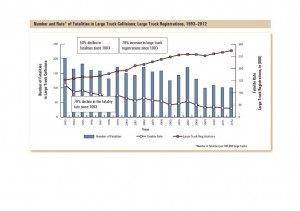Ontario Ministry of Transportation (MTO) Report Confirms Trucks and Truck Drivers Are Safest

The Ontario Ministry of Transportation (MTO) has released the latest edition of the Ontario Road Safety Annual Report (ORSAR). And once again it shows that trucks are the safest vehicles and truck drivers are the safest drivers on the road, says David Bradley, president of the Ontario Trucking Association.
The ORSAR, which contains the results for 2012, states that large trucks (including straight trucks which require a Class D driver’s licence) as well as tractor-trailers (which require a Class A driver’s license), represented just 4.5% of the total number of vehicles involved in all collisions in Ontario. Tractors and tractor-trailers represented only 2.4% of the total number of vehicles involved in all collisions that year.
There were 98 large trucks involved in fatal collisions in 2012 of a total population of 273,765. Of the trucks that require a Class A driver’s licence (tractor-trailers) to operate, there were only 61 – or .02% of the total registered large truck population — involved in fatal collisions. In total, there were 194,746, registered trucks requiring a Class A license.
In comparison to other drivers, large truck drivers involved in fatal collisions are more likely to be “driving properly.” In terms of the number of fatal collisions, the driver of the large truck was driving properly 68% of the time vs 39% for the other driver in the same fatal collisions. In terms of the number of persons killed in collisions with large trucks in 2012, the truck driver was determined to have been driving properly in 79% of the fatalities – the highest level in the past five years and 15.2 percentage points better than in 2008.
In addition, truck drivers are far less likely to have been drinking or impaired by alcohol or drugs – 2% compared to 17% for other drivers involved in the same crashes. In 2012, there was only one recorded collision involving a commercial vehicle where alcohol was involved.
 In terms of the longer-term perspective, OTA compiled data from the ORSAR reports going back to 1993 and found that despite a 79% increase in the number of large trucks registered in Ontario, the number of large truck fatalities decreased from 202 in 1993 to 100 in 2012 – a reduction of 50%.
In terms of the longer-term perspective, OTA compiled data from the ORSAR reports going back to 1993 and found that despite a 79% increase in the number of large trucks registered in Ontario, the number of large truck fatalities decreased from 202 in 1993 to 100 in 2012 – a reduction of 50%.